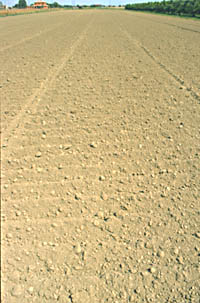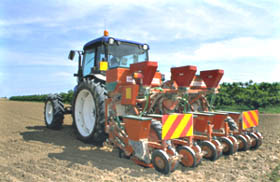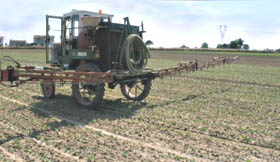

1. Soil
Beans need a well-drained, smooth soil with medium to loose texture. The pH should be between 6.5 and 7.5, active lime percentage should be below 10%. Soil smoothing and breaking are paramount to ensure uniform emergence and consequent maturation. Seedbed preparation requires a rather shallow ploughing (30 – 40 cm.), followed by one or more harrowings to break up clods ad smooth the soil.
2. Fertilization.
A good fertilization plan should be based on soil analysis to best assess what needs to be given to the crop. As a general rule, about a month before seeding, medium-fertility soils are given 100 –120 units of phosphorus (P205 Phosphoric Anhydrite), while K20 Potassium Oxide is given only if necessary. As for nitrogen fertilization, only crops that have a slow growth, particularly spring ones, are given 50 – 70 units of CaNO3 Calcium Nitrate or NH4NO3 Ammonium Nitrate during harrowing. Good results are also obtained with macro- and microelement-based foliage fertilization laced with humic acids. To be avoided are ureal fertilizations and in general great quantities of nitrogen that will cause a disproportionate growth of leaves and stems with consequent lodging and difficulties in mechanical harvesting. If organic matter fertilization (manure, chicken droppings and commercial products) is to be used, it should be applied well in advance in order to allow the organic matter to mineralize.
Seeding should be done with a pneumatic precision seeder, with a conventional row spacing of 45 cm. and plant spacing of 4 – 5 cm., so that 100 – 115 kilograms of seed are sufficient for one hectare. Lately, packages of 100,000 and 20,000 units have become available, saving empirical calculations on the farmer’s part. Seeding depth should not exceed 3 cm., lest the seedlings take a longer time to come out of the ground and emergence is not uniform. A good practice is to have a rolling done after the seeding, so that soil particles can adhere to the seeds.


4.
Weeding.
The short cycle of this crop can pose a problem in weed control, as weeds
are different depending on the seeding season, and herbicides are based
on few active principles. Trifluralin is typically applied before seeding
(with a light amalgamation of the product) or just before emergency, immediately
followed by irrigation. This is effective to control both Gramineae and
large-leaf weeds. In a pre-emergency situation, a mixture of Trifluralin+Linuron
can be used, as it has a wide action range and good selectivity: it is
fundamental for a good crop outcome because no other active principles
are allowed in pre-emergency. Specific Gramineae-fighting agents are available,
although they are not often resorted to. A widely used weed-control practice
is cultivation between the rows when the crop, particularly its root system,
is not yet very developed.